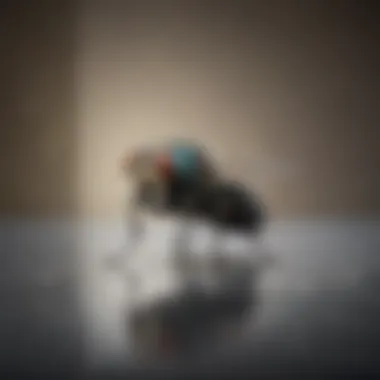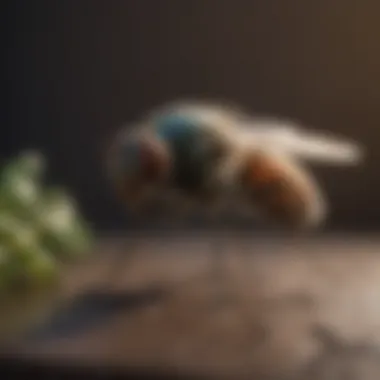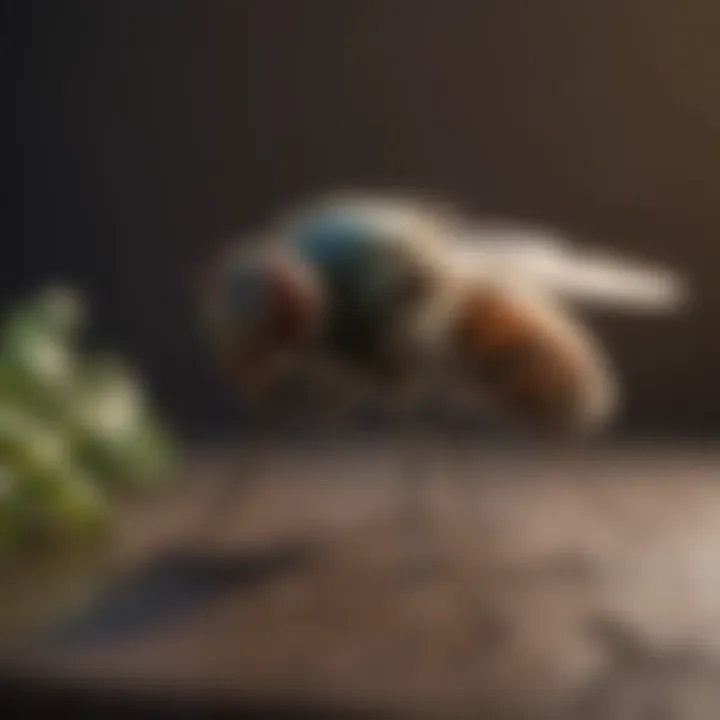Understanding Home Fly Infestations: Causes and Solutions


Intro
Dealing with flies in your home can feel a bit like keeping sand out of your shoes at the beach: it seems like an insurmountable task. These pesky insects not only disrupt our living space; they can also serve as a gateway to bigger issues related to hygiene and comfort. Fly infestations can spring up from a variety of everyday sources, and understanding their nature is paramount. The significance of this topic reaches beyond mere annoyance; the consequences of a fly-heavy home may include worsening cleanliness, danger to food sanitation, and, of course, the emotional burden of constant distraction.
The underlying causes of fly problems often lie in overlooked spaces and forgotten remnants of food. Simple habits can quickly spiral into larger infestations without proper attention. To combat these nuisances, we need to dig into their behavior, life cycles, and most importantly, effective prevention and management strategies. This article aims to sift through the usual misconceptions and equip readers with hands-on techniques and insight in addressing these unwelcome visitors.
From practical sanitation methods to innovative traps and environmental adjustments, homeowners will discover a well-rounded approach that not only tackles immediate concerns but aids long-term prevention. A better understanding of the fly's world might just be the key in reclaiming one’s space from these relentless intruders.
Let’s embark on this journey to enhance the cleanliness and livability of our homes.
Preface to Domestic Fly Infestations
Domestic fly infestations are not just an annoyance; they can signify deeper issues within the household environment. This section serves as a comprehensive guide to understanding how flies invade our spaces—providing insights into the types of flies commonly found indoors and the implications of their presence. Recognizing the importance of understanding these pests can empower homeowners to enact timely interventions and foster a cleaner, more hygienic living space.
Flies often thrive in spaces we might overlook, making it crucial to identify the common attributes and behaviors of these insects. In knowing their impact and breeding preferences, homeowners can not only prevent infestations but also mitigate potential health risks tied to these unwelcome guests. This section sets the stage for a deeper dive into the specifics that follow, such as identifying sources of attraction, understanding how your food and waste disposal habits might play a role, and exploring prevention strategies that focus on both behavior modification and physical controls.
Understanding the Impact of Flies
Flies can be more than just a nuisance; they are vectors for pathogens that can lead to health concerns. Their ability to carry diseases poses a significant threat to food safety in homes, as they can contaminate surfaces and food with bacteria from their bodies or feces. Understanding these risks provides a compelling case for managing fly populations effectively.
"A fly in the ointment can spoil the whole batch."
Common Fly Species Found Indoors
Several fly species have a propensity to invade domestic spaces, and each has unique characteristics that influence their behavior and intrusion. Understanding these species can facilitate more effective management strategies. Below are some of the most common varieties:
Houseflies
Houseflies are perhaps the most recognizable of all flying nuisances. Their sheer prevalence in homes is noteworthy. They tend to frequent kitchens and dining areas, lured by food and waste residues, making them a significant concern for hygiene and food safety. Each housefly can reproduce rapidly, laying hundreds of eggs, which compounds the problem if left unchecked.
A unique feature of houseflies is their ability to quickly adapt to various environments, allowing them to thrive in both urban and rural settings. This adaptability is both advantageous for their survival and disadvantageous for occupants, as it makes extermination more challenging.
Fruit Flies
Often associated with overripe or decaying fruits, fruit flies are small yet mighty in numbers. Their attraction to sugary substances, including soda and spilled juice, means they can appear seemingly out of nowhere in kitchens. They reproduce at an alarming rate, with a female capable of laying up to 500 eggs, demonstrating their potential to turn a minor annoyance into a major infestation.
Fruit flies possess a highly developed sense of smell, which allows them to locate fermenting produce from a distance. This keen ability highlights the importance of proper food storage and disposal as a method to prevent infestations.
Flesh Flies
Flesh flies are less common in indoor environments but can be significantly troubling when they do invade. They are typically attracted to decaying organic matter, such as moldy food or even carrion. Female flesh flies give birth to live young, which can add to the infestation problem quickly.
Their unique feature is their ability to locate decomposing organic material from considerable distances. Hence, the presence of these flies usually indicates serious hygiene issues, such as improper waste disposal. Their need for decaying matter means that preventing their entry often involves ensuring that all organic waste is managed promptly and effectively.
Cluster Flies
Cluster flies are another uninvited fly species that can invade homes—especially during colder months. Different from houseflies, cluster flies seek shelter indoors to escape the chilly weather, often congregating in attics and window sills. Their flight is lazy and slow, making them an easy catch for those trying to manage them.
A distinctive aspect of cluster flies is that they do not reproduce in homes; instead, they lay eggs in the soil, which makes their presence a seasonal issue rather than an ongoing one. However, their tendency to enter homes in groups can make their presence feel overwhelming.
By recognizing and understanding the specific flies that take residence in your home, you can better strategize on prevention and management, ensuring a more pleasant living environment.
Identifying the Source of Flies
Identifying the source of flies in your home is crucial for effectively managing their presence. When you understand where flies are coming from and what is attracting them, you can implement targeted strategies to eliminate the issue at its root. Without this knowledge, you may find yourself merely reacting to a problem that could become persistent.
The significance of recognizing fly sources goes beyond immediate removal. It offers insight into how flies survive and breed in your living space. This understanding can lead to practical steps and an overall cleaner environment, benefiting not just your home’s atmosphere but also your health and well-being.


Food Sources Attracting Flies
Exposed food items
Exposed food items are essentially a buffet for flies. These creatures possess a keen sense of smell and can detect food from quite a distance. If food is left unattended on countertops or tables, it becomes an open invitation for these pests. This characteristic makes exposed food a primary concern in household management.
One unique feature about exposed food is the speed with which it can attract flies. A half-eaten fruit left on the kitchen table can start a fly party in just a matter of hours. Therefore, this aspect is essential in any comprehensive approach to tackling fly infestations. The key is to keep all food covered or stored properly; this simple act can minimize access and greatly reduce the likelihood of bringing flies home with their unwelcomed antics.
Garbage and compost
Garbage and compost are like neon signs guiding flies to their next meal. The odors emanating from decomposing organic matter are irresistable to these insects. Flies breed quickly in trash due to the access to food, making it a significant contributor to worsening infestations.
The accumulation of waste not only attracts flies but also provides them a perfect breeding ground. This creates a cycle that is hard to break if left unchecked. Regularly taking out the trash and sealing it tightly is fundamental in controlling this issue. One peculiar trait about waste is that even a small amount can set off a series of fly visits - just a leftover takeaway container can be all it takes for flies to invade your space.
Spoiled produce
Spoiled produce is another major attractor. Unlike fresh fruits and vegetables, which can physically repel these pests, rotting items emit certain gases that draw them in like moths to a flame. This specific aspect of spoiled produce cannot be overlooked in any discussion about fly management in the home.
A unique feature of spoiled fruits or vegetables is their ability to develop a sticky residue, which can further entice flies and serve as nourishment for their larvae. To combat this problem effectively, regularly checking your pantry and fridge for expired or spoiled items is crucial. The key message here is simple: if you wouldn’t eat it, neither should a fly.
Environmental Conditions Favoring Breeding
Dampness and moisture
Dampness and moisture create an environment conducive for flies to breed. These pesky insects thrive in moisture-laden spaces like kitchens and bathrooms, where water accumulates without proper ventilation. High humidity levels can easily tip the scales in favor of fly reproduction.
One supporting factor is that damp areas often harbor organic materials, making them even more attractive for flies. A leaky faucet or a moist sponge left in the sink can be a fly's paradise. Keeping these areas dry and well-ventilated is a simple yet effective strategy for home maintenance that drastically reduces fly activity.
Organic debris accumulation
Organic debris accumulation is another breeding factor that shouldn’t be underestimated. This can be anything from leftover food particles under the sofa to decaying leaves in the garden. Such debris serves as both food and shelter for flies during their lifecycle.
One key observation about organic debris is that it often goes unnoticed until it reaches a threshold that can no longer be ignored. Therefore, it’s important to regularly clean your spaces, particularly focusing on hard-to-reach corners. By being vigilant, you create barriers that make it less appealing for flies to settle in.
Open access points
Open access points are like a welcome mat for flies. These entryways include cracks around doors, open windows, and gaps in screens that allow easy access to your home. When combined with the previously mentioned factors, they exacerbate the fly situation.
The unique aspect of access points is that they can often be fixed with simple maintenance, such as sealing gaps or installing screens. This strategy reduces the chance of flies entering your home in the first place, which is much easier than dealing with an infestation after it occurs. It's akin to locking the door before going to bed: wise and preventive.
Prevention Strategies
Preventing fly infestations is the cornerstone of maintaining a peaceful and hygienic home. Flies aren't just a nuisance; they can endanger your health and that of your loved ones. By addressing the basic elements of prevention, homeowners can ensure that their living spaces remain fly-free while enhancing overall cleanliness. Having effective prevention strategies not only stops the critters at the door but can also provide peace of mind, allowing you to enjoy your home without the constant worry of a fly invasion.
Sanitation Practices
The importance of sanitation in preventing fly infestations can’t be overstated. Flies are attracted to unclean environments. By committing to clean habits, homeowners can diminish fouled odors that attract these pests.
Regular cleaning routines
Regular cleaning routines are a fundamental aspect in the battle against flies. The key characteristic of a thorough cleaning regimen is its consistency. Weekly and daily cleaning efforts should become habitual to significantly lower the chances of attracting unwanted pests. A detailed and diligent cleaning approach means tackling different areas of your home systematically.
For instance, the kitchen is often the heart of fly activity. Wiping down surfaces, cleaning under appliances, and sanitizing sinks can keep your space uninviting for flies. The unique feature of establishing a regular cleaning schedule is not just about removing visible debris; it is also about eliminating potential breeding grounds where flies can lay eggs. However, it requires dedication and can be time-consuming if an initial deep clean is not performed.
Sealing food items
Sealing food items is crucial for reducing the appeal of your home to flies. One of the key characteristic of this practice is the barrier it creates. Proper sealing helps to lock in freshness and keep out the pests. In the context of this article, utilizing airtight containers is a highly recommended strategy.


The unique feature of sealing food is that it not only keeps flies away but also promotes organization in your pantry or kitchen. This method can vary in effectiveness depending on the material used; for example, glass or thick plastic containers provide strong protection. However, it can be less practical for bulk foods or in large households where access to food is more frequent.
Proper waste disposal
Proper waste disposal plays a vital role in ensuring no leftover food scraps call out to flies. The key characteristic of effective waste disposal is the timely and systematic removal of trash. Regularly taking out the garbage prevents the organic debris that flies love from accumulating. Implementing a routine trash schedule ensures that waste does not linger long enough to attract pests.
One unique feature of this approach is the use of compost bins. While they can attract flies, proper management—like ensuring tight seals and regularly turning compost—can keep odors contained. While user-friendly, some may find it challenging to manage compost without attracting unwanted pests. Overall, these effective waste disposal strategies can dramatically reduce fly presence in and around your home.
Environmental Control Measures
Beyond sanitation, environmental control measures are essential in the overall prevention mix. Adjusting physical conditions in your home can create an atmosphere that is inhospitable for flies.
Adjusting humidity levels
Adjusting humidity levels is one of the lesser-known but effective strategies for fly control. High humidity can enhance the breeding of flies, particularly in kitchens and bathrooms. The key characteristic of this strategy lies in its focus on climate control. By keeping indoor spaces dry and well-ventilated, the chances of attracting flies diminish.
The unique feature of humidity control is the employment of dehumidifiers, which not only deter flies but also improve overall air quality. However, adding dehumidifiers could mean a higher electricity bill, so balance is needed here.
Removing breeding habitats
Removing breeding habitats is another proactive step. Flies tend to breed in places where food waste accumulates. By removing organic debris from various areas, you can make your home less inviting for flies. The key characteristic is essentially keeping areas around the home maintained and tidy.
This method's unique feature is the wide-ranging areas it affects, from clearing gutters to ensuring that yard waste is collected. While it may require ongoing effort, it may also yield long-lasting results in keeping flies at bay. However, it can be challenging if you have a lush garden where organic matter naturally accumulates.
Using window screens and seals
Using window screens and seals is a straightforward but effective barrier against flies entering your home. The key characteristic of this strategy is its physical protection. Installing screens on windows keeps flies from slipping through even the tiniest gaps.
A unique feature of this method is the ease of installation and maintenance. Screens are widely available, and most are quite affordable. However, you will need to ensure these screens do not get damaged or ripped, as even small tears can offer flies a point of entry. Maintaining these preventative measures can halt potential infestations before they begin.
Understanding Fly Behavior
Understanding fly behavior serves as a fundamental aspect when tackling domestic fly infestations. Recognizing their habits aids in prevention and control strategies. Flies often become a nuisance not just because of their presence, but due to their potential to carry diseases. Their behavior reveals insights into where, when, and why they enter our homes, ultimately influencing how we manage them. For homeowners, knowing the behavior of flies helps in maintaining a cleaner and safer space.
Life Cycle of Common Flies
Egg stage
Flies generally start their life in egg form, laying hundreds at a time. This stage is crucial because it marks the beginning of the infestation. The specific characteristic of this stage is how quickly eggs develop—most houseflies, for example, can hatch within a day. This rapid reproduction can swiftly escalate any fly problem. The advantage of understanding this stage is simple: it emphasizes the importance of acting fast when flies are spotted. Acknowledging that a single egg can lead to a swarm takes priority in prevention tactics.
Lava stage
After the egg stage comes the lava stage, where the larvae emerge to feed and grow. This stage is particularly critical since the larvae thrive in decaying matter, making it vital for homeowners to eliminate any sources of organic waste. An intriguing feature of the larva is their ability to consume a diverse range of materials, from left-out food to compost. This stage is beneficial to our discussion because it highlights what attracts flies, pointing directly to sanitation. However, the downside? This stage thrives unseen until they become more noticeable, hence the urgent need for vigilance.
Pupa stage
The pupa stage is when flies undergo metamorphosis. During this time, they are hidden from sight, encased in a protective shell. The unique factor about this stage is the transition it signifies, turning from a larva into a full-fledged fly. Knowledge of this stage aids in understanding why fly populations can seemingly appear overnight: they can be incubating just out of sight. This stage emphasizes the importance of checking food sources and trash regularly, as larvae can quickly transition into flying nuisances.
Adult stage
Finally, there’s the adult stage where flies emerge ready to breed. Adult flies are characterized by their swift movement and ease of landing on surfaces, including food. The important aspect of this stage is their significant role in dispersing and reproducing. Understanding this behavior can guide fly management; for instance, eliminating adults can prevent further infestations. The adult stage blends a mix of fast reproduction and mobility, which often outpaces our capacity to curb them if not addressed promptly.
Flight Patterns and Habitats
Flight habits of houseflies
Houseflies are notorious for their erratic flight patterns. They exhibit short bursts of flying followed by sudden landings, making them unpredictable. This behavior contributes to their ability to land on various surfaces, transmitting pathogens in the process. The most notable aspect is their preference for low altitudes and proximity to food sources. Understanding this makes passive measures like clearing surfaces essential. However, their unpredictability can be a double-edged sword: while they can be annoying, knowing how they move helps set traps effectively.


Behavior of fruit flies
Fruit flies possess a distinct behavior, often gravitating towards fermenting and rotting fruits. What makes them particularly interesting is their ability to locate food sources by scent, even from a distance. This characteristic underscores the importance of handling food properly and disposing of overripe items quickly. Their behavior in swarming around decomposing materials exemplifies the need for regular dietary hygiene in kitchens. They can multiply rapidly, exposing the vulnerability in poor food management practices.
Nesting preferences of flesh flies
Flesh flies favor specific environments such as decaying animal matter, appealing to their reproductive needs. Their nesting habits are primarily linked to their larval feeding preferences, which involve organic decay. This preference makes them less common inside homes but alerts homeowners to the potential hazards of unclean outdoor spaces. In this article, understanding their nesting habits emphasizes ongoing outdoor maintenance. Being aware of their habits gives homeowners a chance to eliminate breeding sites before they even consider entering the house.
"Keeping your home clean is the first line of defense against fly infestations, particularly given their quick lifecycle and adaptability."
In summary, by understanding fly behavior—from life cycles to flight patterns—homeowners can implement effective management strategies to keep these pests at bay.
Human Health and Ethics of Fly Management
The management of flies in our homes transcends mere annoyance. It's closely tied to public health and ethical considerations. Flies are not just uninvited guests; they can bring a host of health risks along with them. Understanding the implications of these infestations can help owners take steps that ensure both their well-being and the responsible treatment of these pests.
Health Risks Associated with Flies
Transmission of diseases
Flies are infamous carriers of numerous pathogens. When they land on spoiled food or waste, they can pick up harmful bacteria. Notably, houseflies can transmit aggressive agents like Salmonella and E. coli. This characteristic of flies makes them a potent concern, as it morphs them into vectors of disease. For homeowners, understanding this aspect highlights the urgency to control fly populations.
The unique feature here is their ability to contaminate food without a second thought, turning an appealing meal into a potential health hazard in seconds. As such, consistent monitoring and sanitation become critical tools in reducing transmission risks.
Contamination of food
Food contamination is another significant risk from flies. When flies buzz around open food, they don't just lend an unsightly scene but also an invisible threat. The key here is their eating habits; flies are known to regurgitate on food before eating it. This characteristic makes food contamination a prevalent concern in homes, especially during gatherings or busy kitchens. Homeowners must stay vigilant about food exposure, as negligence can invite disease through unintentional consumption of contaminated items. The unique feature of this issue lies in the immediate consequences it poses. The inability to spot contaminated food immediately underscores the need for thorough cleaning and awareness.
Allergy considerations
While often overlooked, flies can trigger allergic reactions in some individuals. The proteins found in fly saliva can lead to itchy rashes or respiratory troubles in sensitive people. This key characteristic of fly allergies renders them an unexpected antagonist in household environments. Awareness of this risk is essential for family members who may have existing allergies. This unique aspect, albeit less prevalent, adds another layer of complexity to fly management. Homeowners must balance effective fly control with maintaining an environment that considers the well-being of all residents.
Ethical Considerations in Pest Management
Humane trapping methods
The approach taken to manage flies can carry weighty ethical implications. Humane trapping methods, for instance, offer an alternative to chemical spread. They allow for the capture and release of flies without resorting to lethal methods.
The beneficial aspect of this choice is fostering a humane society without simply exterminating pests. This unique feature contributes to a more respectful co-existence with nature, even if the flies are problematic. As census of a household’s ethical standing comes into question, humane traps exemplify a conscious decision.
Environmental considerations
The environment's health is an essential consideration in pest management. Using environmentally friendly methods can minimize harm to beneficial insects and ecosystems. For example, biodegradable traps or natural repellents can effectively reduce fly populations while keeping ecological balance intact. The key characteristic here is sustainable pest control; it's a choice that safeguards the environment while addressing an invasive problem.
This unique feature showcases how choices made today have far-reaching effects on future generations, making it pivotal for homeowners to be informed about their methods.
Long-term solutions versus short-term measures
There’s a perpetual debate between opting for long-term solutions or relying on quick-fix measures. Long-term solutions, such as establishing barriers and improving sanitation, create lasting effects on fly populations. They contribute positively by reducing repeated infestations and promoting hygiene in living spaces. The defining characteristic of this align is prevention over reaction; it inherently focuses on creating an environment that discourages invasions. The unique feature of this aspect is that although such measures may require more initial effort, they yield benefits that extend beyond mere infestation control, including improved home cleanliness and reduced disease risk.
"A fly within your home can carry more than just the call of nature; it brings a world of health risks and ethical responsibility you cannot ignore."
Finale
The conclusion of this article encapsulates the essential aspects of understanding fly infestations and the measures that can be taken to manage them. By summarizing key points, it solidifies the reader's grasp on the matter. This not only serves a refresher for those who may have skimmed the details but also reinforces the crucial steps needed for prevention and control.
Recap of Key Points
To effectively tackle the complex issue of flies in your home, a condensed overview serves useful:
- Fly Identification: Recognizing common fly species such as houseflies, fruit flies, and flesh flies, and understanding their unique behaviors and breeding habits is essential. This knowledge allows homeowners to respond appropriately to specific infestations.
- Source Identification: Clear identification of potential sources draws attention to what might attract flies—be it overripe fruit, open garbage, or damp areas. Finding these sources can significantly reduce fly sightings.
- Prevention Techniques: Establishing solid sanitation practices, like regular cleaning and proper food storage, plays a pivotal role in prevention. Moreover, environmental controls, such as humidity reduction and sealing gaps, help deter flies from entering living spaces.
- Health Considerations: The associated health risks due to flies—like disease transmission and contamination—highlight the necessity for proactive management.
- Ethical Pest Management: Finally, implementing humane pest control methods emphasizes a balance between necessity and environmental responsibility, promoting sustainable living.
Encouragement for Continuous Learning
Understanding domestic flies is not a one-off task. The changing seasons and varied environmental conditions can lead to new challenges regarding pest management. Therefore, ongoing education in this area remains imperative. Homeowners should seek to stay informed about:
- Best Practices: Engaging in updated sanitation techniques and pest control strategies ensures an effective defense against fly infestations.
- Community Insights: Participating in forums such as reddit.com or local community groups can provide firsthand experiences and solutions. Sharing insights fosters a collective approach to pest management.
- Consulting Experts: When dealing with significant infestations, contacting pest control professionals can save time and energy. Expertise from professionals brings in-depth knowledge that can streamline the resolution process.
Staying vigilant, proactive, and informed about the tactics for prevention and management will greatly benefit homeowners and ensure that flies remain just a minor irritant rather than a larger problem.















